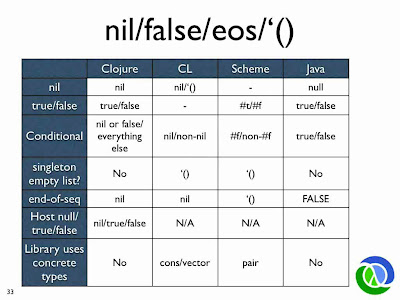In this video, Rich Hickey introduced Clojure for Lisp programmers.
At time 01:10:42, he talked about nil/false/end-of-sequence/'() among Clojure/Common Lisp/Scheme/Java. He said: "Scheme has true and false, but they are broken."

I don't understand why he said that and why does he consider it's "broken"?
It strikes me you'd rather see it from the horse's mouth, so here's a choice extract from a message Rich posted:
The links in that message are also worthwhile, though the second one may be a bit poetic.
From the chart you posted I'd assume it's because Scheme unlike all the other languages in the chart uses something other than
nilorfalseforend-of-seq. Since'()isnon-#fit would be a truthy value in a conditional, but acts as a falsy value for end of sequence checks.In Scheme any value (apart from #f which is False) can be used as True in a conditional test. More info here.
Update Forget this answer, since it's the same for Clojure of course. I don't like this implicit truth for all values that are not false, for example in (println (if 1 "true" "false")). Personally I would consider that broken but Rich is probably thinking of something else.